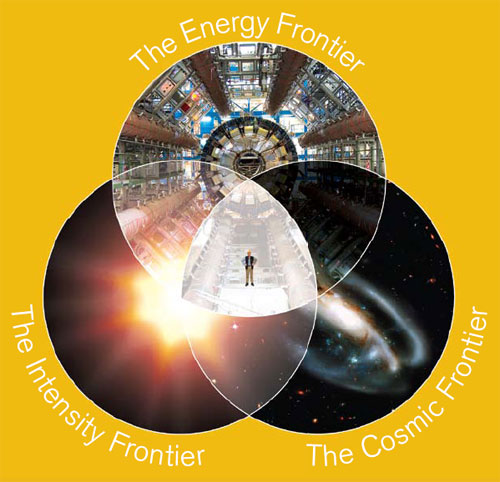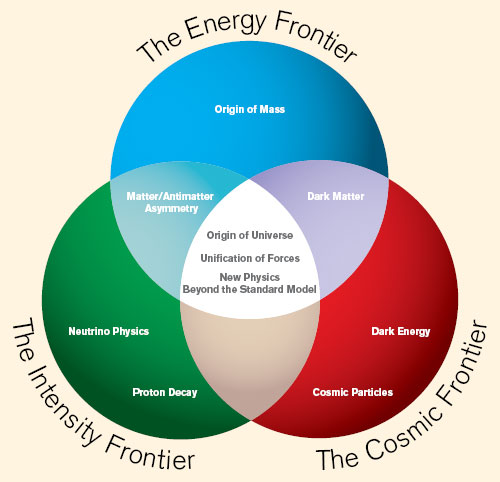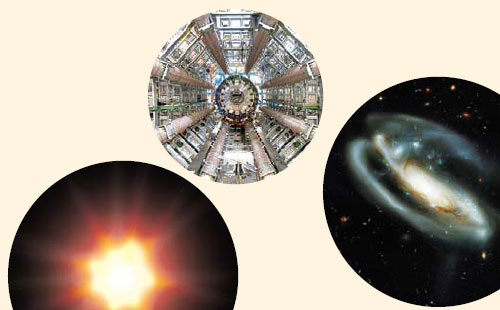New tools forge new frontiers
US particle physics is pushing forward on three frontiers. Each has a unique approach to making discoveries, and all three are essential to answering key questions about the laws of nature and the cosmos.
By Elizabeth Clements
 |
| Photo-Illustration: Sandbox Studio |
In 1665, when natural philosopher Robert Hooke first looked through a microscope at a slice of cork, his view of the world around him changed forever.
Using a microscope he had made himself, Hooke looked at the apparently solid cork and saw a honeycomb of tiny individual structures. He called them cells for their resemblance to monks cells in a monastery. Astonished, he quickly focused his microscope on other natural materials and saw that they too had a cellular structure. Hookes microscope had opened up an unseen world for observation and pointed the way to the cell theory of living organisms.
Hookes fascination with lenses led him to build some of the earliest telescopes. Training them on the heavens, he encountered still more wondrous phenomena.
In Micrographia, his famous account of his research, Hooke wrote:
By the means of Telescopes, there is nothing so far distant but may be represented to our view; and by the help of Microscopes, there is nothing so small as to escape our inquiry; hence there is a new visible World discovered to the understanding. By this means the Heavens are opend, and a vast number of new Stars, and new Motions, and new Productions appear in them, to which all the ancient Astronomers were utterly Strangers. By this the Earth itself, which lyes so near us, under our feet, shews quite a new thing to us, and in every little particle of its matter, we now behold almost as great a variety of Creatures, as we were able before to reckon up in the whole Universe it self.
Every age confronts its own scientific questions and develops its own tools and techniques to address them. In the 17th century, microscopes and telescopes revealed for the first time aspects of the universe invisible to the naked eye. Nearly four centuries later, the tools for observation have changed, but the human imperative to use advances in technology to reveal the nature of the world around us remains.
A new report published by the Particle Physics Project Prioritization Panel (P5), US Particle Physics: Scientific Opportunities, presents 21st century scientific questions about the physics of the universe and describes a set of tools to address them. It defines three frontiers of discoverythe Energy Frontier, the Intensity Frontier, and the Cosmic Frontierwith distinct approaches to particular scientific questions.
Scientific Questions
Fundamental questions about the universe and forces of nature define the path ahead for particle physicists:
- Are there undiscovered principles of nature?
- How can we solve the mystery of dark energy?
- Are there extra dimensions of space?
- Do all the forces become one?
- Why are there so many kinds of particles?
- What is dark matter? How can we make it in the lab?
- What are neutrinos telling us?
- How did the universe come to be?
- What happened to the antimatter?
 |
| Diagram courtesy of P5 |
Energy, intensity and cosmic
At the energy frontier, scientists build advanced particle accelerators to explore the Terascale. There, in this new scientific territory named for the Teravolts of energy that will open it up for discovery, they expect to encounter new phenomena not seen since the immediate aftermath of the big bang. Subatomic collisions at the energy frontier will produce particles that signal these new phenomena, from the origin of mass to the existence of extra dimensions.
At the intensity frontier, scientists use accelerators to create intense beams of trillions of particles for neutrino experiments and measurements of ultra-rare processes in nature. Measurements of the mass and other properties of the neutrinos are key to the understanding of new physics beyond todays models and have critical implications for the evolution of the universe. Precise observations of rare processes provide a way to investigate energy scales at the Terascale and beyond.
At the cosmic frontier, astrophysicists use the cosmos as a laboratory to investigate the fundamental laws of physics from a perspective that complements experiments at particle accelerators. Thus far, astrophysical observations, including the bending of light known as gravitational lensing and the properties of supernovae, reveal a universe consisting mostly of dark matter and dark energy. A combination of underground experiments and telescopes, both ground- and spacebased, will explore these mysterious dark phenomena that constitute 95 percent of the universe.
All of these approaches ultimately aim at the same transformational science, the report says.
We need a diversity of approaches to these questionsa mix of projects both on different timescales and with different scientific reach, says P5 Subpanel member Josh Frieman, a theoretical astrophysicist at Fermilab and the University of Chicago.
Some questions are unique to a single frontier: Only at the cosmic frontier, using highly advanced instruments to observe the evolving universe, can scientists directly explore the mystery of dark energy. In contrast, shedding light on dark matter requires a combination of astrophysical observations and experiments at high-energy particle accelerators. For example, physicists anticipate that experiments at the Large Hadron Collider, soon to begin operating near Geneva, Switzerland, may identify dark matter particles in high-energy collisions. The Cryogenic Dark Matter Search, an experiment half a mile underground in Minnesota, uses a sensitive detector to search for naturally occurring dark matter particles. Gamma-ray detectors in space, such as the recently launched GLAST satellite, may see the glow created when dark matter particles and their opposites collide. Thus a clue from one frontier sheds light on another.
You need to pursue all three frontiers to make progress in particle physics, P5 Subpanel Chair Charlie Baltay, a physicist at Yale University, says.
Facing new realities
In the United States, the field of particle physics is in a time of transition. In a year or two, Fermilabs Tevatron, the worlds highest-energy particle accelerator, will turn off. The energy frontier will move to Switzerland, where the Large Hadron Collider is about to turn on at the European particle physics lab, CERN. More than 1200 US scientists, the largest contingent of CERN experimenters from a single nation, will collaborate in experiments at the LHC.
New budget realities, however, cloud the future of particle physics in the United States.
The proposed International Linear Collider figured as the centerpiece in previous plans for the future of US particle physics. A large cost estimate for the ILC made it likely that a delay in the proposed schedule would occur and led the US particle physics community to re-examine the scientific opportunities ahead.
In December 2007, the Omnibus Funding Bill delivered an unexpected blow, eliminating $90 million in funding for particle physics from the expected budget level for FY08. The diminished funding had a powerful impact on US particle physics, stopping work on several projects, including Fermilabs NOvA neutrino experiment, SLACs B-factory, and all ILC R&D, and leading to layoffs and furloughs.
This is a pivotal point in the US program, says Dennis Kovar, acting associate director of the US Department of Energys Office of High Energy Physics. We need to think harder about how to get at the key science questions with the resources that we have.
The DOE and the National Science Foundation asked P5 to recommend priorities for the future of US particle physics under four budget scenarios:
- Constant level of effort at the FY08 funding level of $688 million
- Constant level of effort at the FY07 funding level of $752 million
- Doubling of budget over ten years starting in FY07
- Additional funding above the previous level, associated with specific activities needed to mount a world-leading program.
By defining scientific opportunities for the fields existing experiments and future proposals, the report attempts to make a balanced plan that maintains the nations leadership role in world-wide particle physics regardless of funding levels.
The scientific priorities have not changed in the last few years, but the context has, Baltay says. The present P5 Subpanel has developed a strategic plan that takes these new realities into account.
The lure of cutting-edge science
Because the United States will soon shut off the Tevatron and doesnt have plans to build another massive accelerator any time soon, the energy frontier is likely to remain in Europe for 20 years or more. However, significant discoveries are within reach at the intensity and cosmic frontiers, leading to proposals for new projects that fit within the new budget realities.
In the immediate future, the physics of neutrinos and the study of rare processes offer unique opportunities to address basic questions of particle physics.
At the time of the big bang, nearly equal amounts of matter and antimatter existed. Since then, however, the antimatter has vanished. Stars, people and everything else that exists consists of matter. What happened to the antimatter?
Physicists believe that neutrinos may be the only particles with mass that are their own antiparticles. If so, they follow a different set of rules from other particles regarding the symmetry between matter and antimatter. Hence, neutrinos have profound implications for the evolution of a universe made of matter. Physicists are eager to build intense proton sources to make unprecedented numbers of neutrinos for experiments that will illuminate their unique properties.
Physicists can also use intense proton sources to observe rare processes in nature. Rare particle decays can peek into a higher-energy regimefar in excess of the energies the LHC can directly reach. By observing the decay patterns of particles with long lifetimes, such as muons and kaons, scientists may catch glimpses of heavy new particles whose brief cameo appearances can alter normal decay processes.
Physicists must sift through billions of particle decays to find these rare events that could answer questions about the nature of matter and energy, the evolution of the universe and the subtle differences between matter and antimatter. High-intensity accelerators can create the immense numbers of particles they need.
The more, the better, says P5 subpanel member Robert Tschirhart, a physicist at Fermilab. The currency here isnt energy. Its intensity.
At the cosmic frontier, physicists observe naturally occurring particles such as gamma rays to investigate the nature of the universe. Highenergy gamma rays are photons, or particles of light, that are millions to hundreds of billions more energetic than the light people see. They are typically emitted from powerful astrophysical phenomena such as supermassive black hole systems and rapidly spinning neutron stars, revealing fundamental physical processes that are impossible to investigate in terrestrial laboratories.
Gamma rays may also be emitted when massive particles interact weakly with their surroundings the same weak interactions that are a hypothesized property of dark matter particles. The recently launched Gamma-ray Large Area Space Telescope, or GLAST, a NASA/DOE collaboration with international partners, hopes to find these dark matter signatures, among other intriguing phenomena. Stanford Linear Accelerator Center managed the construction project for the primary instrument, the Large Area Telescope, or LAT, and played a key role in the instrument assembly. Scientists based the LAT on acceleratorbased particle detector technology adapted for use in space.
Where frontiers converge
The intensity and cosmic frontiers could meet in the Homestake Mine in South Dakota. There the proposed Deep Underground Science and Engineering Laboratory, or DUSEL, presents an opportunity for scientists from multiple fields to conduct experiments.
In this dedicated underground laboratory, geologists would study the Earths subsurface; microbiologists would have access to organisms living in the Earths depths; experts in rock mechanics would analyze how rock reacts to pressure over time; and particle physicists would move closer to solving the mysteries of the universe.
Making such a large, diverse undertaking a reality requires a high degree of cooperation and collaboration from multiple funding agencies. The agencies already have begun collaborating on big projects. The DOE and NSF, for example, jointly funded the US contributions to the Large Hadron Collider at CERN. The DOE and NASA jointly fund GLAST.
DUSEL is also a collaboration, in this case between DOE and the NSF. At 2400 meters below ground, DUSEL would provide more shielding from cosmic rays and other surface noise than any previous underground particle physics environment. At the cosmic frontier, DUSEL would make an ideal spot for directly detecting dark matter particles. At the intensity frontier, it could host neutrino experiments. The P5 report calls for sending a high-intensity neutrino beam from Fermilab to Homestake Mine, where a large detector would record any changes that occurred during the particles 1300-kilometer journey.
Experiments at DUSEL would address many issues, including neutrino physics, proton decay, dark matter, and neutrinoless double beta decay, Baltay says. DOE and NSF should define clearly the stewardship responsibilities for such an experimental program.
Helps for the eye
At the dawn of the era of modern science, the extraordinary power of early microscopes and telescopes to reveal the nature of the world around them gave 17thcentury scientists a sense of nearly limitless scientific opportunity, and they foresaw future generations of increasingly powerful tools for discovery.
Tis not unlikely, Hooke wrote in Micrographia, but that there may be yet invented several other helps for the eye, as much exceeding those already found, as those do the bare eye, such as by which we may perhaps be able to discover living Creatures in the Moon, or other Planets, the figures of the compounding Particles of matter, and the particular Schematisms and Textures of Bodies.
As 21st-century physicists contemplate the power of such helps for the eye as next-generation accelerators, detectors, telescopes, and cameras, they have a similar sense that these tools at the frontiers of particle physics are about to change their view of the universe forever.
 |
| Photos courtesy of CERN and NASA |
Click here to download the pdf version of this article.






